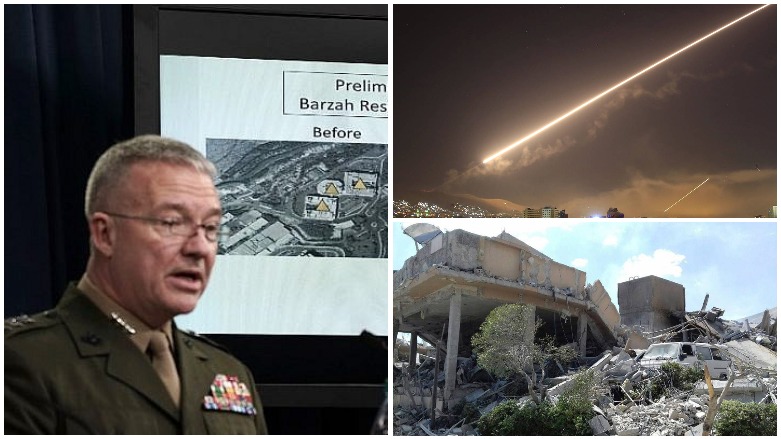Coalition Strikes on Syria Detailed: Barzah Center was most important target

WASHINGTON DC (Kurdistan 24) – The Pentagon provided a detailed account of the coalition missile strikes on chemical weapons facilities that took place at 4:00 a.m. on Saturday morning in Syria.
The Director of the Joint Staff. Lt. Gen. Kenneth McKenzie, named the three targeted sites. The most important was the Barzah Research and Development Center, where the regime worked on chemical and biological weapons.
The Barzah Center, located on the outskirts of Damascus, consisted of three buildings.
They were “destroyed,” McKenzie said, displaying “before and after” pictures of the structures, now reduced to rubble.
Saturday’s strike “set the Syrian chemical weapons program back for years,” McKenzie affirmed.
The two other strikes, at targets located west of Homs, hit less significant sites: a chemical weapons storage facility and a chemical weapons bunker seven kilometers away from the storage facility.
Notably, while US, French, and British missiles all struck the chemical weapons storage facility and French missiles were used against the bunker, only US missiles attacked the Barzah Center.
Nearly three-quarters of the munitions fired in the attack—76 out of 105 missiles—were launched at the Barzah Center, underscoring its significance.
Russian officials claimed that Syria, which has Russian-supplied air defenses, shot down 71 coalition missiles. However, McKenzie affirmed that “none of our aircraft or missiles involved in this operation were successfully engaged by Syrian air defenses.”
Indeed, although Syria fired some 40 surface-to-air missiles, “most” were launched after the coalition strikes were over, McKenzie said.
Russia maintains air defenses in Syria, but they were not employed against the coalition.
Gen. Sergei Rudskoi, of the Russian General Staff, who proclaimed the supposed success of Syria’s air defenses, also said that Russia might provide its S-300 air defense system to Syria, which would be more effective than anything Damascus has now.
Were that to happen, it could cause problems for Israel, which has enjoyed relative freedom in carrying out bombing attacks in Syria, including against Iranian targets there, the British Guardian suggested.
The coalition used aircraft as platforms to launch the missiles, as well as ships, some of which were based in the northern part of what McKenzie called the “Arabian Gulf,” also known as the Persian Gulf.
The shortest route to Syria from there lies over Iraq. Baghdad has vociferously protested the coalition strikes. However, it seems likely that the coalition used Iraqi air space to carry out the attack.




